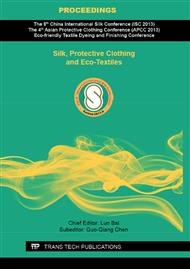[1]
L. Zhang: Chinese Bulletin of Entomology Vol. 46 (2009), p.509.
Google Scholar
[2]
W. M. Xiu, S. L. Dong: ACTA ENTOMOLOGICA SINICA Vol. 48 (2005), p.778.
Google Scholar
[3]
S. X. Zhang. W. Z. Cui And G. X. Wang: CANYE KEXUE Vol. 35 (2009), p.776.
Google Scholar
[4]
B. H. Sandler, L. Nikonova and W. S. Leal: Chemistry & biology Vol. 7 (2000), p.143.
Google Scholar
[5]
S. Mohanty, S. Zubkov: Journal of molecular biology Vol. 337 (2004), p.443.
Google Scholar
[6]
A. Lartigue, A. Gruez: The Journal of biological chemistry Vol. 278 (2003), p.30213.
Google Scholar
[7]
S. W. Kruse, R. Zhao and D. P. Smith: Nature structural biology Vol. 10 (2003), p.694.
Google Scholar
[8]
A. Lartigue, A. Gruez: The Journal of biological chemistry Vol. 279 (2004), p.4459.
Google Scholar
[9]
D. P. Gong, P. Zhao and Y. Lin: ACTA ENTOMOLOGICA SINICA Vol. 49 (2006), p.355.
Google Scholar
[10]
T. Sakurai, H. Mitsuno and S. S. Haupt: PLoS Genetics Vol. 7 (2011). p.1.
Google Scholar
[11]
K. E. Kaissling and E. Priesner: Naturwissenschaften Vol. 57 (1970), p.23.
Google Scholar
[12]
K.E. Kaissling and G. Kasang: Naturwissenschaften Vol. 65 (1978), p.382.
Google Scholar
[13]
T. Fujii, S. Namiki: P NAS Vol. 108 (2011), p.18038.
Google Scholar
[14]
M. Forstner, T. Gohl and H. Breer: Invertebrate Neuroscience Vol. 6 (2006), p.177.
Google Scholar
[15]
G. B. Wang, Y. H. Chen: ACTA ENTOMOLOGICA SINICA Vol. 54 (2011), p.589.
Google Scholar
[16]
J. Qing, N. J. He and Z. H. Xiang: SCIENCE OF SERICULTURE Vol. 36 (2010), p.645.
Google Scholar
[17]
J. Sambrook, D. R. David: Molecular Cloning: A Laboratory Manual (3rd) (Cold Spring Harbor Laboratory Press, New York 2002).
Google Scholar
[18]
D.H. Wang, T. Han: PLANT PHYSIOLOGY COMMUNICATIONS Vol. 40 (2004), p.75.
Google Scholar
[19]
J. M. Lassance, A. T. Groot and M. A. Liénard: Nature Vol. 466 (2010), p.486.
Google Scholar
[20]
T. Sakurai, H. Mitsuno and S. S. Haupt: PLoS Genetics Vol. 7 (2011). p.1.
Google Scholar
[21]
C. S. Willett, R. G. Harrison: Insect biochemistry and molecular biology Vol. 29 (1999), p.277.
Google Scholar
[22]
V. Campanacci, J. Krieger: The Journal of biological chemistry Vol. 276 (2001), p.20078.
Google Scholar
[23]
H. Watanabe, H. Tabunoki and N. Miura: Invertebrate neuroscience Vol. 7 (2007), p.109.
Google Scholar


